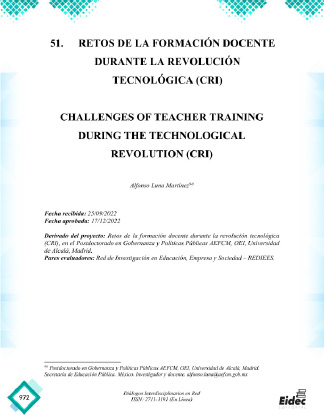LI. RETOS DE LA FORMACIÓN DOCENTE DURANTE LA REVOLUCIÓN TECNOLÓGICA (CRI)
##plugins.themes.bootstrap3.article.main##
Resumen
Esta ponencia da cuenta del referente teórico conceptual de la investigación:
“Recomendaciones para la formación de docentes en educación básica, frente a la Revolución
Tecnológica” en el marco del Postdoctorado en Gobernanza y Políticas Públicas AEFCM,
OEI, Universidad de Alcalá, Madrid. En la misma indago y rescato el dispositivo (con
centralidad en los saberes) que los docentes de educación básica en México desplegaron
frente a las emergencias educativas derivadas del advenimiento de la pandemia Covid-19;
así como del contexto más amplio que representa la Cuarta Revolución Industrial. La
investigación en su conjunto es de corte hermenéutico-analógico y de Nuevo Realismo
(construcción desarrollada desde los postulados de Beuchot, Foucault, Deleuze, Gadamer,
Ferraris, Jerez y Agamben), los resultados de la misma se presentarán en posteriores
comunicaciones como sugerencias de políticas públicas formativas para docentes adecuadas
al contexto referido.
Download Statistics
##plugins.themes.bootstrap3.article.details##
Formación docente, Cuarta Revolución Industrial, Dispositivo formativo, Revolución Tecnológica, Hermenéutica analógica, Nuevo realismo.
Andión, M. (2011). La integración de las TIC a la educación formal como problema de
investigación. En REencuentro. Análisis de Problemas Universitarios, (62),10-19.
Disponible en: https://www.redalyc.org/articulo.oa?id=34021066002. Consultado el
19 de Septiembre de 2022.
Beuchot, M. (2022). La hermenéutica analógica y sus ámbitos. Análisis, 54(100).
https://doi.org/10.15332/21459169.7036
Deleuze, G. (1990). ¿Qué es un dispositivo? En Michel Foucault, filósofo. España: Gedisa.
(pp. 155-165).
Didriksson, A. (2013). Prólogo. En Andión, M., Arias, D., et. al. (2013). Símbolos digitales.
Representaciónes de las TIC en la comunidad escolar. México: UAM/SIGLO XXI.
(pp. 9-13).
Ferraris, M. (2012). Manifiesto del nuevo realismo. Chile: Ariadna Ediciones
Gadamer, H. (1995). El giro hermenéutico. España: Gráficas Rogar, S.A.
Jerez, J. El nuevo realismo analógico. En Beuchot, M. (2014). Dar con la realidad.
Hermenéutica analógica, realismo y epistemología. Argentina: Círculo
hermenéutico. (pp. 145-162).
Lizarro, D. (2013). Introducción. En Andión, M., Arias, D., et. al. (2013). Símbolos digitales.
Representaciónes de las TIC en la comunidad escolar. México: UAM/SIGLO XXI.
(pp. 15-20).
Primero, L. (2021). La enseñanza del Covid-19. En Primero, L. (coord.) (2021). El efecto
Covid-19 y la educación en México. Mexico: Publicar al Sur. (pp. 21-62).
Sánchez-Castañeda, A. (2019). La cuarta revolución industrial (industria 4.0). Entre menos
trabajo, nuevos empleos y una cíclica necesidad: la protección del trabajador
asalariado y no asalariado. México: Instituto de investigaciones Jurídicas UNAM.
Disponible en: https://bit.ly/3xAy5gG. Consulta del día 12 de septiembre de 2022.
UNESCO (2022). En 2022, transformemos la educación para un futuro con más esperanza:
UNESCO. Disponible en: https://bit.ly/3qSoaiY. Consulta del 15 de septiembre de
2022.





